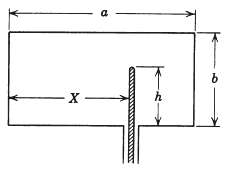The figure shows a cross-sectional view of an infinitely long rectangular waveguide with the center conductor of
Question:
The figure shows a cross-sectional view of an infinitely long rectangular waveguide with the center conductor of a coaxial line extending vertically a distance h into its interior at z = 0. The current along the probe oscillates sinusoidally in time with frequency w, and its variation in space can be approximated as I(y) = I0 sin [(w/c) (h - y)]. The thickness of the probe can be neglected. The frequency is such that only the TE10 mode can propagate in the guide.

(a) Calculate the amplitudes for excitation of both ?? and TM modes for all (m, n) and show how the amplitudes depend on m and n for m, n >> 1 for a fixed frequency w.
(b) For the propagating mode show that the power radiated in the positive z direction is

with an equal amount in the opposite direction. Here ? is the wave number for the TE10 mode.
(c) Discuss the modifications that occur if the guide, instead of running off to infinity in both directions, is terminated with a perfectly conducting surface at z = L. What values of L will maximize the power flow for a fixed current I0? What is the radiation resistance of the probe (defined as the ratio of power flow to one-half the square of the current at the base of the probe) at maximum?
Step by Step Answer:






